|
 Our
Nearest Neighbour Our
Nearest Neighbour
New Caledonia
A New Horticultural Mecca
Reproduced from an article
by Dr John Dawson
From The New Zealand
Garden Journal (Journal of the Royal New Zealand Institute of Horticulture),
Vol. 2, No. 4, December 1997, pp. 8-11.
An Australian plant collector,
Alistair Watt, recently described New Caledonia as having one of
the richest and most beautiful floras in the world and further stated
"Since 1987, I have developed a 'love affair' with New Caledonia,
much as Kingdon-Ward and Forrest felt about western China". Watt
took seeds, collected during five expeditions, back to Melbourne,
where a special section is now being developed at the Botanic Garden
"to exhibit the best and most interesting of these new floral treasures".
Some nurseries are also looking at bringing some of these novelties
into more general cultivation.
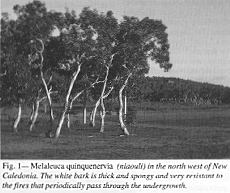 I
have visited New Caledonia 15 times over more than 30 years to undertake
botanical research, particularly into the family Myrtaceae. In 1992
and 1994 Rob Lucas accompanied me and we collected seed of a number
of species of horticultural merit. This seed went to several recipients
in the North Island, including Victoria University, the Wellington
Botanic Garden and the Auckland Regional Botanic Garden. There are
now well grown young plants of a number of species. At the Wellington
Botanic Garden some of these will be tried in containers in the
Begonia House and others will be planted in suitable sheltered sites
in the open. I
have visited New Caledonia 15 times over more than 30 years to undertake
botanical research, particularly into the family Myrtaceae. In 1992
and 1994 Rob Lucas accompanied me and we collected seed of a number
of species of horticultural merit. This seed went to several recipients
in the North Island, including Victoria University, the Wellington
Botanic Garden and the Auckland Regional Botanic Garden. There are
now well grown young plants of a number of species. At the Wellington
Botanic Garden some of these will be tried in containers in the
Begonia House and others will be planted in suitable sheltered sites
in the open.
New Caledonia lies about
half way between North Cape and New Guinea at 20-22 degrees south.
The main island is long and narrow, 400 km long by 40-60 km wide,
which are approximately the dimensions of the North Auckland Peninsula.
New Caledonia though is ruggedly mountainous with some peaks more
than 1600 m high.
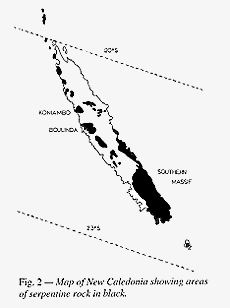 The
climate is tropical, although the relatively high latitude means
that there is a 'winter' season that can sometimes be cool but certainly
not cold. Rainfall is higher in the east than the west, the normal
pattern in the tropics, and is probably everywhere sufficient to
support forest of some type, even on the mountain tops. However,
those arriving in New Caledonia for the first time at Tontouta Airport
in the west, might wonder whether they had arrived in Australia
by mistake. They
see dry looking hills covered with green, white trunked trees that
could be a species of Eucalyptus. It is in fact a very
fire resistant species of Melaleuca, M. quinquenervia,
known locally as 'niaouli'. However, the more observant visitor
might notice that in gullies on the hills there are patches of dense,
dark green rain forest. The gullies give some protection from the
fires that blaze all too frequently on these slopes. Before humans
arrived with their fire some thousands of years ago, it is thought
that the western side of New Caledonia was covered by dense forest.
There are still extensive rain forests at higher altitudes in the
mountains and on the wetter east coast, but even here there can
be incursions by fire in the drier season. The
climate is tropical, although the relatively high latitude means
that there is a 'winter' season that can sometimes be cool but certainly
not cold. Rainfall is higher in the east than the west, the normal
pattern in the tropics, and is probably everywhere sufficient to
support forest of some type, even on the mountain tops. However,
those arriving in New Caledonia for the first time at Tontouta Airport
in the west, might wonder whether they had arrived in Australia
by mistake. They
see dry looking hills covered with green, white trunked trees that
could be a species of Eucalyptus. It is in fact a very
fire resistant species of Melaleuca, M. quinquenervia,
known locally as 'niaouli'. However, the more observant visitor
might notice that in gullies on the hills there are patches of dense,
dark green rain forest. The gullies give some protection from the
fires that blaze all too frequently on these slopes. Before humans
arrived with their fire some thousands of years ago, it is thought
that the western side of New Caledonia was covered by dense forest.
There are still extensive rain forests at higher altitudes in the
mountains and on the wetter east coast, but even here there can
be incursions by fire in the drier season.
The other factor that
sometimes inhibits the development of forest is much more ancient
and botanically more interesting, as it has lead to the evolution
of many unusual and sometimes very attractive species over millions
of years. This factor is serpentine rock which occupies a third
of the area of New Caledonia. This rock type is very low in mineral
nutrients useful to plants and is often high in toxic metals, such
as nickel and chrome. The soil derived from this rock can usually
only support sparse and stunted vegetation able to tolerate the
infertility and toxicity. Serpentine rock is found in New Zealand
on Dun Mountain near Nelson and in the Olivine Range in Fiordland.
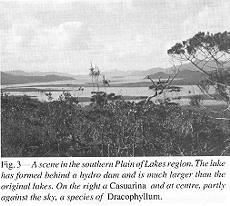 In
New Caledonia the largest serpentine area is in the southern third
of the main island, where it is easily accessible from Noumea. The
landscape here differs from that elsewhere in New Caledonia. There
are a series of wide basins, with swamps or small lakes in their
lowest parts surrounded by hills. On the level sites and the ridges
of the hills there is a sometimes dense cover of shrubs or small
trees, the latter often having a distinctive candelabra arrangement
of their branches. In the gullies and valleys of the hills tall
forests sometimes develop with some very big trees, including species
of Araucaria and the related Agathis (includes
our kauri). This southern vegetation is rich in species and many
of them are attractively shaped and in some cases bear large brightly
coloured flowers. In
New Caledonia the largest serpentine area is in the southern third
of the main island, where it is easily accessible from Noumea. The
landscape here differs from that elsewhere in New Caledonia. There
are a series of wide basins, with swamps or small lakes in their
lowest parts surrounded by hills. On the level sites and the ridges
of the hills there is a sometimes dense cover of shrubs or small
trees, the latter often having a distinctive candelabra arrangement
of their branches. In the gullies and valleys of the hills tall
forests sometimes develop with some very big trees, including species
of Araucaria and the related Agathis (includes
our kauri). This southern vegetation is rich in species and many
of them are attractively shaped and in some cases bear large brightly
coloured flowers.
Plant families with a
long history in the southern hemisphere are strongly represented.
The conifer genera Araucaria and Agathis have
already been mentioned. Species of Araucaria are the most
distinctive trees of New Caledonian landscapes, ranging, with different
species, and on all rock types, from the coast along the ridges
of hills, up to the mountain tops. Along the coast the most notable
species is Araucaria columnaris with its pencil or rocket-like
shape, sometimes 70-80 metres tall by a metre or so wide. Of the
19 species of Araucaria in the world, 13 are restricted
to New Caledonia.
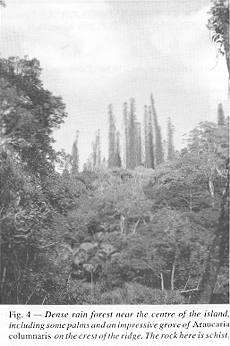 There
are also other conifers of the podocarp family, to which most New
Zealand conifers also belong. There
are also other conifers of the podocarp family, to which most New
Zealand conifers also belong.
Among flowering
plants the Casuarina genus is also prominent in this southern
region. The New Caledonian species are attractively shaped with
densely rounded crowns. Species of Nothofagus are also
present, although their leaves are a surprise as they are much larger
than those of our species.
The
Protea family is conspicuous and includes spindly small
trees of Grevillea with large pink or cream inflorescences.
The Cunoniaceae include species related to our kamahi, but many
of them are dense, rounded shrubs with bright pink, red, or yellow
flowers. Other members of this family have the flowers crowded in
spherical heads. The family Myrtaceae, the largest in New Caledonia,
is also strongly represented. There are relatives of our ratas with
bright red flowers and many other genera with fleshy or dry fruits.
The most notable genus horticulturally though is Xanthostemon,
ranging throughout the island, mostly on serpentine. The flowers
of the 22 species are large and mostly bright red or yellow.
At higher altitudes on
the mountains in the north of the southern serpentine region, and
on island-like serpentine mountains ranging to the far north, different
species or different genera appear. There are Araucaria
of candelabra form and other species that are so short they could
qualify as bonsais by comparison with the tall coastal trees. A
notable incomer at these higher sites is the only other species
of Xeronema in the world, X. moorei. It is often
very abundant on rocky sites. It is a smaller species than ours,
but still highly attractive when in flower.
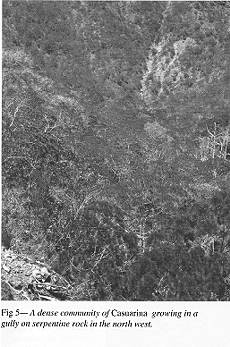 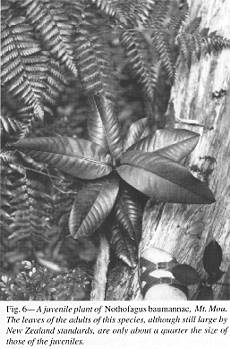 |
|
Rain forests on soils
derived from normal rocks, greywacke, schist etc., have a different
aspect. Conifers are less conspicuous with tree ferns and palms
being more prominent. Among the tree ferns are two species that
may be the tallest in the world, up to 30 metres in height with
trunks up to a metre in diameter near the ground. Higher altitude
tree ferns are miniatures by comparison with very slender trunks.
There are 36 species of palm, many of them with slender, elegant
and sometimes very tall trunks.
A few botanical curiosities
have evolved in New Caledonia. In the Plain of Lakes region in the
far south there is a dwarf semi-aquatic podocarp conifer. Its short,
often submerged trunks, at the edges of rivers or lakes, are conspicuously
swollen at the base. At the same locality there is an always completely
submerged species of Blechnum fern. It grows out from crevices
in deep river pools. Most remarkable of all, however, is the only
known parasitic conifer in the world, appropriately named Parasitaxis.
It is a spindly shrub, with dark red-purple foliage, that parasitises
the roots of another podocarp conifer.
Botanically, New Caledonia
is a fascinating place with its strong representation of ancient
southern hemisphere families as well as tropical Asian families.
The evolution of distinctive and attractive species on the serpentine
terrain adds a further interesting dimension.
Horticulturally too,
New Caledonia has much to offer. Its potential in this respect is
only just beginning to be realised.
| Dr.
John Dawson is Senior Associate in the School of Biological
Sciences, Victoria University of Wellington. He has a
particular interest in the flora of New Caledonia and
has written the first of two volumes on Myrtaceae for
the Flora of New Caledonia. He is currently working on
the second volume. |
|
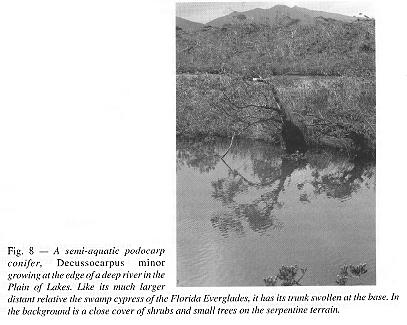 |
More
Journal Articles
|



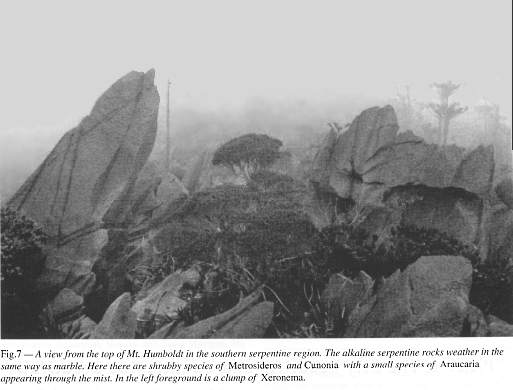


 Our
Nearest Neighbour
Our
Nearest Neighbour I
have visited New Caledonia 15 times over more than 30 years to undertake
botanical research, particularly into the family Myrtaceae. In 1992
and 1994 Rob Lucas accompanied me and we collected seed of a number
of species of horticultural merit. This seed went to several recipients
in the North Island, including Victoria University, the Wellington
Botanic Garden and the Auckland Regional Botanic Garden. There are
now well grown young plants of a number of species. At the Wellington
Botanic Garden some of these will be tried in containers in the
Begonia House and others will be planted in suitable sheltered sites
in the open.
I
have visited New Caledonia 15 times over more than 30 years to undertake
botanical research, particularly into the family Myrtaceae. In 1992
and 1994 Rob Lucas accompanied me and we collected seed of a number
of species of horticultural merit. This seed went to several recipients
in the North Island, including Victoria University, the Wellington
Botanic Garden and the Auckland Regional Botanic Garden. There are
now well grown young plants of a number of species. At the Wellington
Botanic Garden some of these will be tried in containers in the
Begonia House and others will be planted in suitable sheltered sites
in the open. The
climate is tropical, although the relatively high latitude means
that there is a 'winter' season that can sometimes be cool but certainly
not cold. Rainfall is higher in the east than the west, the normal
pattern in the tropics, and is probably everywhere sufficient to
support forest of some type, even on the mountain tops. However,
those arriving in New Caledonia for the first time at Tontouta Airport
in the west, might wonder whether they had arrived in Australia
by mistake. They
see dry looking hills covered with green, white trunked trees that
could be a species of Eucalyptus. It is in fact a very
fire resistant species of Melaleuca, M. quinquenervia,
known locally as 'niaouli'. However, the more observant visitor
might notice that in gullies on the hills there are patches of dense,
dark green rain forest. The gullies give some protection from the
fires that blaze all too frequently on these slopes. Before humans
arrived with their fire some thousands of years ago, it is thought
that the western side of New Caledonia was covered by dense forest.
There are still extensive rain forests at higher altitudes in the
mountains and on the wetter east coast, but even here there can
be incursions by fire in the drier season.
The
climate is tropical, although the relatively high latitude means
that there is a 'winter' season that can sometimes be cool but certainly
not cold. Rainfall is higher in the east than the west, the normal
pattern in the tropics, and is probably everywhere sufficient to
support forest of some type, even on the mountain tops. However,
those arriving in New Caledonia for the first time at Tontouta Airport
in the west, might wonder whether they had arrived in Australia
by mistake. They
see dry looking hills covered with green, white trunked trees that
could be a species of Eucalyptus. It is in fact a very
fire resistant species of Melaleuca, M. quinquenervia,
known locally as 'niaouli'. However, the more observant visitor
might notice that in gullies on the hills there are patches of dense,
dark green rain forest. The gullies give some protection from the
fires that blaze all too frequently on these slopes. Before humans
arrived with their fire some thousands of years ago, it is thought
that the western side of New Caledonia was covered by dense forest.
There are still extensive rain forests at higher altitudes in the
mountains and on the wetter east coast, but even here there can
be incursions by fire in the drier season. In
New Caledonia the largest serpentine area is in the southern third
of the main island, where it is easily accessible from Noumea. The
landscape here differs from that elsewhere in New Caledonia. There
are a series of wide basins, with swamps or small lakes in their
lowest parts surrounded by hills. On the level sites and the ridges
of the hills there is a sometimes dense cover of shrubs or small
trees, the latter often having a distinctive candelabra arrangement
of their branches. In the gullies and valleys of the hills tall
forests sometimes develop with some very big trees, including species
of Araucaria and the related Agathis (includes
our kauri). This southern vegetation is rich in species and many
of them are attractively shaped and in some cases bear large brightly
coloured flowers.
In
New Caledonia the largest serpentine area is in the southern third
of the main island, where it is easily accessible from Noumea. The
landscape here differs from that elsewhere in New Caledonia. There
are a series of wide basins, with swamps or small lakes in their
lowest parts surrounded by hills. On the level sites and the ridges
of the hills there is a sometimes dense cover of shrubs or small
trees, the latter often having a distinctive candelabra arrangement
of their branches. In the gullies and valleys of the hills tall
forests sometimes develop with some very big trees, including species
of Araucaria and the related Agathis (includes
our kauri). This southern vegetation is rich in species and many
of them are attractively shaped and in some cases bear large brightly
coloured flowers. There
are also other conifers of the podocarp family, to which most New
Zealand conifers also belong.
There
are also other conifers of the podocarp family, to which most New
Zealand conifers also belong.